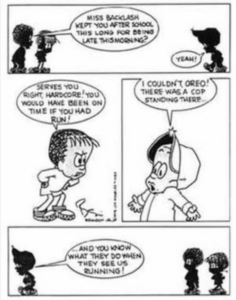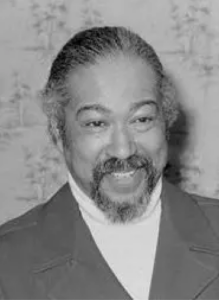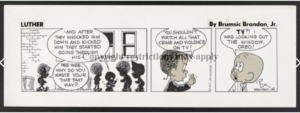Cartoonist Profile
Brumsic Brandon Jr. was born on April 10, 1927 in Washington, D.C.. He was married to his wife, Rita, for sixty four years. Together they had three children; Barbara, Linda, and Brumsic III. Barbara also went on to become a cartoonist. He attended college at NYU and studied art. While in school he was regularly submitting comic strips to mainstream magazines and newspapers. Shortly after graduating, he was drafted into the U.S. Army where he earned the rank of Sergeant after two years in Germany. After his time in the Army, he worked in animation for RCA and Bray Studios. Throughout his various jobs, he would produce cartoons after hours and on weekends. Brandon contributed his work to a number of different sources. One being a magazine produced by Freedom Movement. He contributed his work to multiple African American media outlets. During all of this, he bounced around the U.S., living in Long Island, NY for a long time, spending a few years in the Poconos of Pennsylvania, and wound up spending the rest of his life in Cocoa Beach, Florida.


Brandon was the creator, and best known, for the comic strip “Luther”. Prior to “Luther”, Brandon collected twenty two of what he determined were his most socially conscious comics and turned them into a book called, “Some of my Best Friends”, to which he personally distributed. In 1966, his work was picked up into a collection called, “Damned If We Do, and Damned If We Don’t”. This collection helped push his comic career in tremendous ways. He was heavily involved in the African American journal about culture and literature, “Freedom Ways”. He developed political cartoons quarterly for them for many years. He was also heavily involved with “Black Resources”. He worked for these two journal’s throughout his entire career and created a following. His work turned heads and got a lot of notice for the way he was presenting the issue of racism in America. “Luther” was syndicated from 1968 to 1986. “Luther” was first picked up by the New York newspaper, Newsday, that was distributed on Long Island. Shortly after Newsday picked him up they were bought by Los Angeles Times, where “Luther” became syndicated nationwide. It was one of the first nationally syndicated comic strips to feature a mainly African-American cast. The main character is a third grade, African-American kid and his friends in a poor neighborhood of Washington, DC.. The name came about after inspiration from Dr. Martin Luther King Jr.. The objective of “Luther” was to bring to light the struggles and perspective of African-Americans, and in specific, of African-American kids. He got ideas from his own childhood experience growing up in the city. He used what had happened to him and what he experienced and turned it into a positive. The goal of “Luther” was to let children know they are not alone and educate and inform the rest of the world what is happening and what these African-American kids are experiencing in Washington D.C.. He used child protagonists and satirical undertones to convey the message of racism and multiculturalism. Brandon wanted his comics to be relatable and readable to all viewers. By using children characters and short comics, he is able to get his message across to young kids as well as having an impact on adults reading it. This comic strip is a great example of what Brandon tried to encapsulate for his strip, “Luther”. In this strip the main character was being told he was, “served right”, not being consoled by his friends for being late to school. Where Brandon stands apart from other cartoonists is explaining his experience as an African-American kid in a city. The main character turns to say, “I couldn’t Oreo! There was a cop standing there”. Text like this, that is short and simple that gets the point across to people of all ages. It explains the struggles that African-American kids go through that other kids would not have to ever think about. Brandon created hundreds of comic strips under “Luther”. He published on a daily basis making it nearly impossible to track down all of the “Luther” comic strips. Another strip of “Luther”, describes the crime these kids were seeing. In this strip, Pee Wee is telling a group of kids about how these men were beating up another man by knocking him to the ground, kicking him, and going through his pockets. As he is describing this, Oreo interrupts and tells Pee Wee he is wasting his time watching all of these crime television shows. Pee Wee turns back wide-eyed and says “TV?! I was looking out the window, Oreo!”.

This is another great example of what these kids were witnessing in the inner city. It is organized and written so it could be understood by children but also very well understood by adults and very impactful for all seeing it. It is only three panels long consisting of four text bubbles with all the exchanges being between Pee Wee and Oreo. His characters are created with detail, but not too much detail as to take away from his main argument, the text. Many of Brandon’s comics were set up in this format. While his ideas streamlined to political issues he also highlighted inner city struggles. In a string of “Luther” strips he addresses poverty. For example, in one strip two characters are conversing on a summer day. Going back and forth about how it is hot out and he wished he had money for vacation. One character asked the other, “Where would you go on vacation?”. The response was “Nowhere! I’d buy an air conditioner”. In presenting poverty such as this it is understandable and relatable for kids who wish they had air conditioning and also relatable or kids who do have it, realizing there are other people who do not. Brandon’s cartoons are readable and understandable for children and adults.
A topic I discovered while completing the Timeline JS project was Brumsic Brandon Jr.’s involvement in a children’s television show that aired in New York, Joya’s Fun School. This series ran from 1972 to 1982 and Brandon was a frequent guest on the show. The show’s purpose was to teach children and Brandon ran a segment. In this segment he taught children about comics and animation. He also created his own puppet, Seymour the book worm, to aid in his segment to engage the children. In an episode, Brandon is seen teaching kids how to draw something starting from a letter. He takes the letter “a” and adds a face, hair and arms to create a little girl. He continues and does this example with the letters “w”, “t”, and the number six. With each, he created different images to engage the children and give them a place to start with drawings. This footage is extremely valuable as there are very few, if any other, videos, interviews, or footage of Brandon, even more specifically, Brandon creating work.
https://www.youtube.com/watch?v=h3kyInYI-SE
(Check out Brandon giving drawing tutorials, 10:50-13:15)
Something else I discovered about Brandon is an exhibition after his death. The exhibition was put up in 2020 as a joint exhibition with his daughter, Barbara Brandon-Croft, work. It was titled “Still… Racism in America: A Retropersepctive in Cartoons” and was shown at the Medialia Gallery in New York. Brandon was not known to host his own exhibitions so, it is a unique way for Barbara to honor her father and keep his legacy going.
Brumsic Brandon Jr. lived an incredible and impactful life. His work broke boundaries in the world of comics and brought up extremely important issues in America. He worked as an Army Sergeant, animator and created his own comics. He published his own book, “Some of my Best Friends” which included twenty two of what he felt were his most impactful comics displaying the theme of racism. He was heavily involved with freedom movements during his lifetime, publishing comics into journals such as “Freedom Ways” and “Black Resources”. He also enjoyed teaching, in a television show, Joya’s Fun School, Brandon educated children on how to create comics. He did this for ten years. His most notable comic strip, “Luther”, became the first nationally syndicated comic strip to include a mainly African American cast and feature all African American main characters. This strip displayed the struggles of racism and multiculturalism young children experience in Washington D.C., based on his own childhood experiences. “Luther” ran for eighteen years, from 1968 to 1986. When “Luther” came to an end and he decided to retire, his retirement did not last long. Brandon could not stay away from creating and publishing his work. He created comics for “Florida Today” out of Cocoa Beach, Florida until his death. Brandon was married to his wife, Rita, for sixty four years and had three children, Barbara, Linda, and Brumsic III. Barbara took after Brandon, and became a cartoonist herself. Her work is inspired by her father and she continues to keep his work alive, incorporating his work with hers and using themes he used in her work. A large collection of the “Luther” comics can be found in the Billy Ireland Museum on the campus of Ohio State Universities library. Ones missing from this collection are housed in the Library of Congress. However, there are still some missing due to the large amount of strips produced by Brandon.
Check out and Interview (0:00-6:40) with Barbara Brandon-Croft about Brumsic Brandon Jr.
Sources:
Brandon. “Brandon, Brumsic, Jr., 1927-2014.” Digital Collections, library.osu.edu/dc/concern/generic_works/6m311r734?locale=en. Accessed 28 Oct. 2023.
Legacy.com, and Legacy. “Brumsic Brandon Obituary (1927 – 2014) – Cocoa Beach, FL – Floridatoday.” Legacy.com, December 2, 2014. https://www.legacy.com/us/obituaries/floridatoday/name/brumsic-brandon-obituary?id=16611647.
“Luther. and He Started Non-Violent Demonstrations!” The Library of Congress, www.loc.gov/item/2016687376/. Accessed 28 Oct. 2023.
“Object Record.” Luther – Brandon, Brumsic, Jr., 1927-2014 | Ohio State University – Cartoon Library & Museum, osucartoons.pastperfectonline.com/Webobject/71425E41-1210-48FA-BE14-739226541147#gallery-1. Accessed 31 Oct. 2023.
Publisher, Oxford Comics NetworkFollow this. “How to Study Comics & Graphic Novels: A Graphic Introduction to Comics Studies.” Issuu, February 9, 2021. https://issuu.com/oxfordcomicsnetwork/docs/how_to_study_comics___graphic_novels-a_graphic_int.
“The Story of Still.” YouTube, YouTube, 11 May 2022, www.youtube.com/watch?v=mlj_Fhhi_zQ.
Vitello, Paul. “Brumsic Brandon Jr., Creator of ‘luther’ Strip, Dies at 87.” The New York Times, December 3, 2014. https://www.nytimes.com/2014/12/03/arts/design/brumsic-brandon-jr-creator-of-luther-comic-strip-dies-at-87.html.
“12. Seriously Funny.” Tales from the Vault 40 Years 40 Stories, library.osu.edu/site/40stories/2020/01/29/seriously-funny/. Accessed 28 Oct. 2023.
Comic Strip Profile
Wikidata Profile
There are a ton of differences in creating longform virtual exhibits and creating a virtual timeline. In a longform virtual exhibit you are restricted to one form, one page to get all your information in. In a virtual timeline you have more freedom to organize and add. In a timeline you can have specific dates with long captions that remain hidden until you progress to them. In a longform exhibit all the information is visible at once. A timeline allows more specificity in dates and details with better organization.
Timeline JS
[timeline src=”https://docs.google.com/spreadsheets/d/1ILsWb50XnRJ5oiNWhQAm2m2Hnf2cEQJQcG4w-rEwN3I/edit#gid=0″ width=”100%” height=”650″ font=”Default” lang=”en” version=”timeline3″ ]
The process for this project was super fun and interesting. I had never used timeline before and it was an interesting experience learning about it, how to use it, and how to utilize it. To create my timeline, I first went through the information I previously had obtained from our weekly wordpress assignments. From there, I laid out the information I had and organized it by year. Brumsic Brandon Jr. published and created comics for many different sources. However, I did not have much information on multiple of these places of publication. In trying to look through books he published, and were published early on, I skimmed through the books to find his comics and they greatly followed his mission and values. His book he published himself I could not get access to but I am interested in gaining access to see more of his work. This book was published in 1963 and he personally distributed it to family and friends. I dove deeper into his places of publications, like Freedom Ways and Black Resources. Freedom Ways has all of their issues stored in an online catalog. Going through, you can find Brandon’s comics within these quarterly issues. However, while looking into his publication with Black Resources I could not find much. I could find that he did publish with them about his political cartoons. In an interview with his daughter, Barbara, she mentions his publications and work with Black Resources and how much he loved it and believed in the cause. However, other than that there is not much electronically published on his work here. In further searching, I discovered that over two years he appeared on television. In a local New York children’s show he appeared showing children how to create comics and animation. Brandon loved teaching people and using children as his vessel to teach. I found it very difficult to find any interviews of Brumsic but did find one with his daughter, as mentioned above, that was very insightful to details that would not be mentioned in other articles. This video gave details to his passion for his mission and creating. It gave details into his work with Freedom Ways, Black Resources, and the creation of Luther along with creating after that. From that interview, I found out that Brandon continued to create until he physically could not due to Parkinson’s disease. His work was still being published after Luther had ended. The process of creating this timeline allowed me to visually see Brumsic Brandon Jr.’s life and publications formally laid out. The process greatly helped me organize my thoughts and information. Learning about his life, family and publications rounded my overall knowledge of Brandon and makes me excited to keep learning about him and his work.
Student Bio

Nicole Burney is a senior at the University of Richmond. She is majoring in Visual and Media Arts with minors in Art History and Women, Gender, and Sexuality Studies. She is also a member of the Women’s Lacrosse team. She has enjoyed taking a course on digital humanities to see the intersect between media arts, women gender studies, and the digital humanities. She plans to pursue a career in media and use what she has learned in this digital humanities course to guide her work. She has enjoyed researching the cartoonist Brumsic Brandon Jr. and expanding her knowledge on other sections of the arts.
Comments
One response to “Nicole Burney – “Brumsic Brandon Jr.””
I thought you did a great job analyzing the comic strip that you chose, speaking upon the meaning of the strip and why it is written the way it is. I thought it was very meaningful to learn about the background of the comic and Brumsics reason for writing it. One thing that I would like to know more about is how it effected the comic world as a whole since it is one of the first nationally syndicated strips with a mostly black cast. I think I could help you add a bit more about the comic strip that you chose and the little actions he took to make the comic stand out.